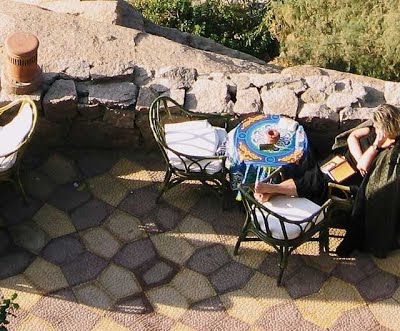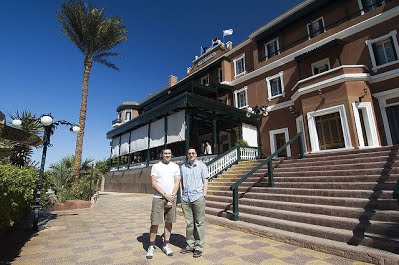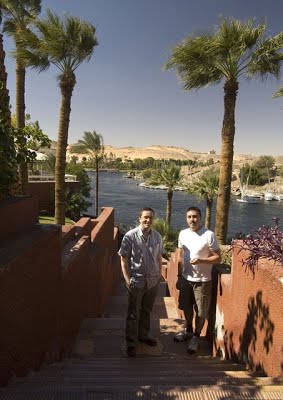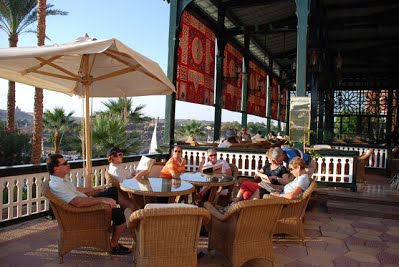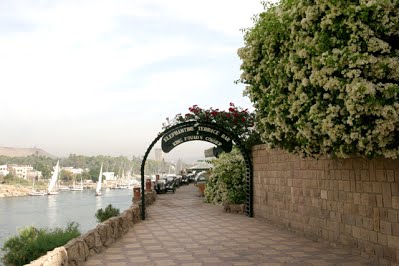On occasion, some of the sightings of the pavings are more notable than others as regards their history, location, and extent, of which these instances being of importance/substance than of ‘general street sightings’ are thus discussed in more detail aside from such instances. These specific instances include the Old Cataract Hotel, in Aswan (here), and at the American University in Cairo (AUC). To begin, some background detail as to the Old Cataract Hotel itself, followed by the pentagon aspect.
The Old Cataract Hotel, in Aswan (some 450 miles south of Cairo), built in 1899 as one of Egypt's monuments to its colonial period, has an interesting history per se, being one of the ‘grand hotels’ of the past, synonymous with luxury, prosperity and refinement. The Old Cataract is perched atop a granite hill at the Nile river's edge, and takes its name from the rivers First Cataract (rapids) at the traditional northern border of Nubia. It was Thomas Cook, the grand tour manager of Egypt who had the hotel constructed, mostly for the tourists that his company was escorting down the Nileat the end of the 19th century. Unlike many historical hotels in Egypt, it was never a royal palace or lodge. It has always been a grand hotel. Today, under the management of Sofitel, it remains one of the finest hotels in Egypt. For over a century many notable people have stayed there, including Howard Carter, the Aga Khan III, Tsar Nicholas of Russia, Winston Churchill, the Duke of Connaught, the 3rd son of Queen Victoria, King Farouk of Egypt, The Shah of Iran, Nahas Pacha, Khedive Abbas Helmi Sovereign of Egypt, and Mohamed V King of Morocco. The Old Cataract was always a favourite of the elite during Egypt's British colonial period, and with the release of the movie written by Agatha Christie and Anthony Shaffer, 'Death on the Nile' in 1978, the hotel received a grand revival of interest. Regarding the pavings, of the two types of pentagons, individual pentagons are used, extensively, in a variety of locations in the grounds, detailed below, in the ‘butterfly’ type colour configuration, but of tan and red, rather than black and white of the AUC. As to when the pavings were installed, this is open to speculation. The earliest dated photograph is in The Glory of Egypt, by A. Van der Heyden of 1982, and likely in an earlier edition, not seen, of 1974. However, this sighting at the Old Cataract hotel must be qualified. As such, it only seen from an aerial view, from afar, of diagram 39 (the book is not paginated). Strictly, the sighting is not discernable, with foreknowledge required to surmise the paving, albeit this can only indeed be the paving as sought and known from clearer, unambiguous photos. Likely, the pavings are considerably older than 1982/1974, but exactly how old is open to speculation; it could even be by many decades. Upon my investigations and interactions with the Old Cataract Hotel authorities, and in particular Laëtitia Huré, the personal assistant to the general manager, no suitable pictures has been found in the archives. (Laëtitia also gave me some rather disconcerting news in that the pavings are now no longer there! The hotel underwent extensive renovation in 2008-2011, resulting in the pavings being replaced! What a loss!) Although there is no evidence that these predate the earliest sightings I have elsewhere (at the Galaa club in Heliopolis), of 1956, there is a possibility that these could be so, and so hence my determination to pursue this. As ever in this investigation, an open invitation to the reader, does anyone have documentary evidence of the pavings in photographs predating the 1982/1974 account above, and ideally much earlier? The picture does not have to be ‘magnificent’; a mere fragment of the tiling will suffice for dating purposes, or indeed an aerial shot showing what can be surmised to be the paving. This could be a significant lead as possibly of one of the earliest installations, given the great age of the hotel. As ever, I am open to ideas from readers of this page as to obtaining a picture. Aside from the more obvious picture searches, another approach is that of examining old film of the Old Cataract, of which given its notable history would thus be more likely to have been filmed than a generic hotel. However, save for one instance, I have not been able to find anything in this line. The one instance I have on film is the well-known ‘Death on the Nile’, of 1978. However, upon examining the entire film, the Old Cataract features only fleetingly, in a few of the early scenes, generally from afar. That said, there is one brief instance where a reasonably close-up sighting is a possibility, of the steps as in the Trevor Lowe photo, where the view is looking down below the steps. However I am far from convinced that the paving is as shown, but it could indeed be; it’s simply hard to tell due to the camera angle and brevity of shot. Indeed, so brief (a couple of seconds) is it that blink and you’ll miss it! The exact period is 26 minutes, 36-37 seconds. Previously, this was available on the web, but no longer seems available. Is there anybody interested enough in having a look, and giving me their thoughts? If indeed confirmed, this would be significant, the first filmed footage, although not likely now the first confirmed sighting, likely of 1974, above. And who is not to say that it could even be much earlier; perhaps one of the first instances dating back to late 1950s or even more! Does anyone know of any such footage? With the Old Cataract being so prominent in history, it is perhaps a little surprising that I have not been able to find such footage.
A few open questions: 1. Has anyone seen the Old Cataract paving in books/newspapers/journals on Egypt that predate the earliest instance I have, of 1982? I might just add that the best source is ‘travel guidebooks’ on Egypt (rather than scholarly tomes concerning ancient history). 2. Has the Hotel been filmed? Anything save for ‘modern times’ I would be interested in. 3. Laëtitia Huré told me the paving are/were manufactured in small factories in Aswan, rather than ordered from Cairo. However, no further specific detail was forthcoming. Does anyone know of these ‘small factories’? 4. Is there any anecdotal evidence? I am unfamiliar with any. Any suggestions to progress the investigation are welcome. © Tom Curtis Aerial view of the Old Cataract; with foreknowledge, the pavings are just discernible © Tom Curtis The pavings in relative detail © Trevor Lowe At the Entrance to the Hotel © Trevor Lowe Steps leading to the Nile © Teo Ibernón
© Linda Allery Verandah
© Benjamin E. Wood Elephantine Entrance Bar Created 12 July 2012. Last updated 22 September 2015, in light of a new finding of an earlier sighting, in the book 'The Glory of Egypt' |
Cairo Tiling >

